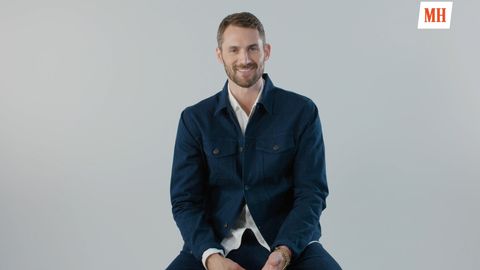At some point after, I dunno, maybe the 12th time that the pandemic did not in fact “end,” my Hot Vax Summer got so compounded by stress—another kid on the way, dad in the hospital, cross-country move—that I felt almost blind. A tic, which began with occasional blinking, had devolved into a full-on facial contortion, all squinting and snorting and—ahem!—a socially awkward clearing of the throat. Strangers asked if I was okay, then shuddered. I wore sunglasses in the shade.
The eye doctor deferred to Therapist No. 1, also known as my judgmental analyst and her weekly hour of couch-bound guilt, but rambling about my mother was no cure for a case of the blinks. For a second opinion, I turned to my second mental-health regular—aka Therapist No. 2, aka my psychiatrist, aka the overpriced drug dealer for my anxiety medication—then asked her to refer me to a third opinion. And a fourth. And a fifth. If you could expect a menu for your mouth, I figured, why not a buffet for your brain? Why order the usual when you could try it all and choose a new favorite?
My shrink suggested three additional options: a solo specialist in a different, more interactive brand of therapy; a self-help group; and a textbook featuring 422 pages of mental-health workouts. Indeed, I was assured that any one of these referrals could function more like a new personal trainer offering exercises in cognitive jujitsu—no Xanax required, no couches allowed. Determined to outsmart the tic at any cost or insurance premium, I signed up for all of the above. These new modalities might take at least a month or two to rewire my worst instincts, but then, as Therapist No. 3 soon promised, “You become your own therapist.”
Therapist No. 3: The Radical
Stefanie Sugar, Psy.D., struck me as more of a teacher, really, than a judge. At our initial appointment, the founder of New York City’s Behavioral Psych Studio navigated me through the school of problem-solving known as dialectical behavioral therapy. DBT was first developed in the 1970s by the revered psychologist Marsha Linehan, Ph.D., for patients with urges toward self-harm and borderline personality disorder who’d sat on the couch for years, invalidated and in danger. “The problem,” Linehan once said, “is talking—being listened to and understood—doesn’t necessarily make anything change.” Her method was not to diagnose madness but rather to engage a commitment, then to build a lifelong tool kit that could be tailored for the shrink averse.
DBT has since expanded into an entire university of mindfulness to address everyday stressors including sleepless nights and partner conflicts. Linehan always sort of cribbed from Buddhism, Sugar told me, and the most relevant of today’s behavioral-therapy brain hacks is a decidedly Zen approach: “radical acceptance.”
In the face of crises as sprawling as Covid or as personal as a tic, our natural instinct is denial, especially and obviously when it comes to bad habits like drinking and gambling. But let’s say you’re a tennis fanatic and you’ve started to feel a pinch in your back lately—a bad pinch that docs haven’t been able to resolve. What if, instead of presuming you’d never pick up a racket again, you admitted to having that pain in bed each morning and decided not to let it bother you? What if I stopped worrying about snorting like a pig and learned to love the tic? “Radical acceptance sounds really kind of simple,” Sugar said, “but it’s incredibly difficult to practice, because we don’t want to do it—the radical is in there because it takes all of you.”
At the end of our next session, Sugar gave me my first homework assignment since college: a stress diary, which was more like an Apple Notes file to log all the places where I flared my nostrils, coughed unnecessarily, or blinked too hard—walking dog, pushing stroller, taking a leak. But the act of documenting my habits revealed their hiding place. We can be at our most stressed-out during moments of alleged calm, when our anxiety floats toward catastrophe and our emotions give way to an urge. “Anticipate those urges,” then walk away or close your eyes, Sugar told me. “Just don’t pee all over the toilet or anything.”
Which I did, several times. And my diary proved that the moments I was blinking most often were…when I was typing up the diary. So Sugar helped me employ a different set of three letters: CBT, for cognitive behavioral therapy, emphasizing not so much long-term self-care as immediate, targeted tricks. She taught me to tolerate stress and create new mannerisms—you know, the opposite game. When I sensed a snort coming on, I breathed out of my mouth like Darth Vader at a yoga class. An ahem erupted; I swallowed my spit instead. As with any intensive regimen, behavioral reps pay off: Five weeks into my therapeutic pupu platter, I was picking up dog shit each morning with one eye open while exhaling through my dad-bod belly instead of my snout. The tic wasn’t totally gone, but in my radicalized mind, I knew it never could be.
Therapist No. 4: Fight Club for Your Mind
I had plenty of sessions with Sugar ahead, one-on-one, but I kinda missed those reunion Zooms of the early pandemic—fraternities, aunties, Hamilton—when we could swap solitude for solace, personal anxiety for an orchestra of it. And I did have an hour and a half free on Thursdays. So I signed up for eight weeks of the DBT self-help group that was recommended by my shrink, at the Center for Anxiety in New York City, with eight total strangers.
The first rule of Group was you must show up for Group. The second rule of Group was…you do not log out of Group. The cheerleader of a host shared TED Talks on his screen, then asked if everyone was ready to use their “wise mind.” Crickets. Sitting through this Zoom made me nod off faster than watching bad golf on TV. But there was real talk amid the woo-woo, and in the fourth week, a woman in the top-left box of our Group grid explained that she had been worried about the primal, hunter-gatherer fear of becoming ostracized from friend groups, so she’d brazenly been more vocal than the rest of us. I unmuted myself and confessed that, in a pandemicized panic, I’d straight-up forgotten how to make friends in the first place.
That week at daycare drop-off, I admitted to Group, a cool new dad had introduced himself; I’d disguised my eye convulsion behind a pair of Ray-Bans, fogged up my mask, and airballed a fist bump. This was not merely anxiety, which my longtime analyst had originally identified as the source of the tic. This was shame, explained our Group leader—the urge may be to hide, but the opposite game says to let your secret out. I began to speak about my tic freely in and out of Group, like Ed Norton in Fight Club crying into Meat Loaf’s man boobs. I’d thought I craved company, but what I truly needed was feedback—not a couch but a springboard.
“No type of therapy is going to make the pandemic go away,” Marcia Kimeldorf, Ph.D., director of clinical services at the Center for Anxiety, reminded me. “Everybody’s freaking out. So to be able to have that group is a lifeline—and it’s based on learning tools and skills, not telling us your deepest, darkest secrets or the way your mom treated you as a kid.”
Therapist No. 5: Acronym Overload
Despite occasionally tripping over the dog leash with my eyes closed, I was virtually blink-free seven weeks into this self-induced therapy binge. But the stress behind the tic had only advanced: Two daughters were indeed a handful, tuition was getting expensive, and now my wife’s dad was in the hospital. Group had equipped me with general brain hacks and YouTube bookmarks, but between the morning meditation, a different doc every other day, and my actual personal trainer, I hadn’t found much time for Group’s homework.
My fellow Groupers and I had relied upon a spiral-bound textbook by Linehan, the OG of DBT, which made for a decent coaster. Flipping through DBT Skills Training one night during a blowout in the NBA playoffs, though, I realized these tear-away handouts contained multitudes of free mindfulness. I scanned the index for acronyms: ABC stood for Accumulate positive emotions, Build mastery, and Cope ahead of time—not easy. Habit reversal therapy (HRT) had me turning up my palms, prayerlike, in a drill designed for people who pull out their hair. And then there was the STOP method: Stop, as in freeze; Take a step back; Observe how your body is clenched; and Proceed mindfully, knowing that you are not gonna make it to daycare on time with that new kid.
As with any good wine list, however, there is such a thing as too much tasting. Brain-hack memorization only added to my general anxiety. The ahems returned, and my mental-health calendar left too little room for after-school parenting. But a friend recommended the startup Minded, which connected me to a guy on Zoom who could efficiently prescribe my meds for $60 a month. “Like Netflix,” he said. And I’d come to appreciate that Therapist No. 1 had, for an hour every week, been making me do all the talking, without any of the teaching, all along.
At the conclusion of my two-month exercise, I dumped both my analyst of six years and the psychiatrist who’d recommended her own competition in the first place. I continued with Sugar for the tic but considered how to spend the out-of-network savings elsewhere. Art therapy, maybe. I’d heard they were taking patients in the metaverse.
But my eyes were open. I had become a radical. Now every Saturday could be Opposite Day. So I got back out there, to the true rager that is a four-year-old’s birthday party. I gathered myself for ten seconds at the door, in a state of fatherly Zen, and immediately lost my older daughter, only to find myself surrounded by four stranger dads. One of their aging parents was in the hospital as well. Two of them were solo parenting for the weekend. Another was new in town. With each piñata crack of awkwardness, our pandemic PTSD let loose a little more. We had become therapists for ourselves, then for one another. I took off my sunglasses and jumped into the bouncy castle.
This story originally appeared in the September 2022 issue of Men’s Health.
This content is imported from OpenWeb. You may be able to find the same content in another format, or you may be able to find more information, at their web site.




Comments are closed.